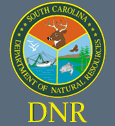Conclusions and Future Directions
Results obtained from the SCECAP surveys indicate that most of South Carolina's
estuarine habitats are in good condition. Estuaries in which a large proportion
of habitat coded as fair or poor were primarily located in developed watersheds
such as portion of Charleston Harbor and Winyah Bay. Other areas, such as the
northern portion of the ACE Basin, had no obvious sources of human influence. The quality of South Carolina's coastal habitats also can be tracked over time,
and can be compared to ongoing assessments in neighboring states being conducted
in partnership with the EPA's National Coastal Assessment (NCA) Program. For
example, the NCA Program found that the southeast region, of which South Carolina is a part, has the best
overall habitat quality of the six regions monitored in the US (USEPA
2001). However, SCECAP has found evidence of changes in the condition of
our coastal waters consistent with the expected impacts of ongoing
urbanization. Continued monitoring of South Carolina's coastal condition will
be necessary to determine whether this trend is early evidence of a longer-term
trend or a reflection of natural fluctuations.
The quality of South Carolina's coastal habitats also can be tracked over time,
and can be compared to ongoing assessments in neighboring states being conducted
in partnership with the EPA's National Coastal Assessment (NCA) Program. For
example, the NCA Program found that the southeast region, of which South Carolina is a part, has the best
overall habitat quality of the six regions monitored in the US (USEPA
2001). However, SCECAP has found evidence of changes in the condition of
our coastal waters consistent with the expected impacts of ongoing
urbanization. Continued monitoring of South Carolina's coastal condition will
be necessary to determine whether this trend is early evidence of a longer-term
trend or a reflection of natural fluctuations.
The detailed information on water quality, sediment quality, and biotic condition collected through SCECAP sampling efforts provides a valuable database on the current status of South Carolina's tidal creek and open water habitats. The SCECAP database has already been tapped by programs within the SCDNR as well as by other governmental agencies and nonprofit organizations. For example, the NOAA Dolphin Survey and the NOAA Oceans and Human Health Initiative (OHHI) have mined the SCECAP database in order to relate estuarine environmental measures with dolphin health and land use characteristics, respectively. In 2002-2003, a multi-agency study was conducted for the Town of Bluffton to assess the existing health of the May River (Van Dolah et al., 2004b). That study utilized a comparable sampling approach and relied on existing SCECAP sampling to obtain data from relatively pristine estuarine locations sampled in the southern portion of the state for comparison as reference sites, thereby considerably reducing expenses for the Town of Bluffton. The Nature Conservancy has used the SCECAP database to evaluate the condition and integrity of the Sewee-Santee-Winyah estuarine complex in order to develop a conservation action plan for the area. Additional analyses have also been completed using SCECAP and other databases to evaluate the relationships between land use patterns and estuarine habitat quality (Van Dolah et al., 2008) with the longer-term goal of developing models describing the interactions between human development and coastal ecosystems.
Funding for SCECAP through the USEPA was terminated after the 2006 survey period. This necessitated a major restructuring of the program with respect to environmental variables assessed and number of sites sampled per year. Given the growth in South Carolina's coastal zone and the likelihood that this will result in further degradation of our estuaries, it is imperative that the SCDNR and SCDHEC maintain this cooperative program to identify trends in estuarine habitat quality. Only an adequate holistic monitoring program will allow us to detect these changes and subsequently act to reduce or avoid serious degradation of our coastal zone.

